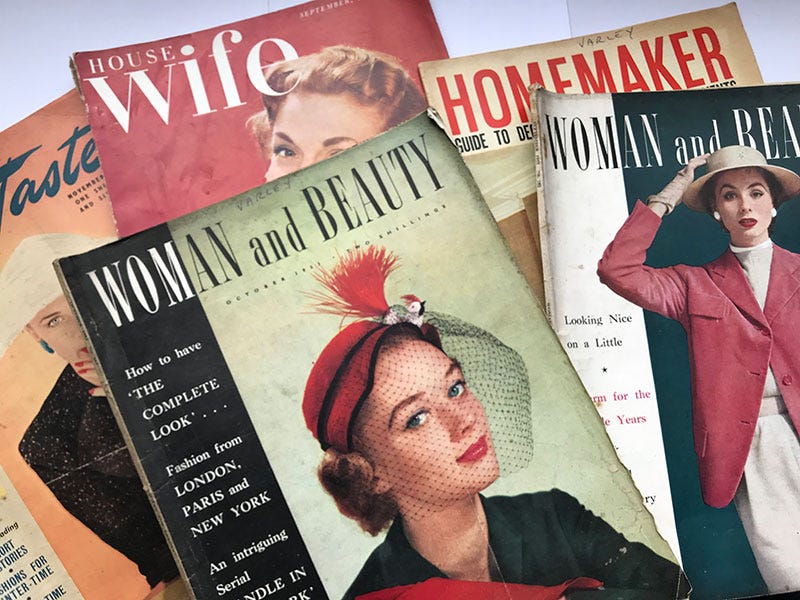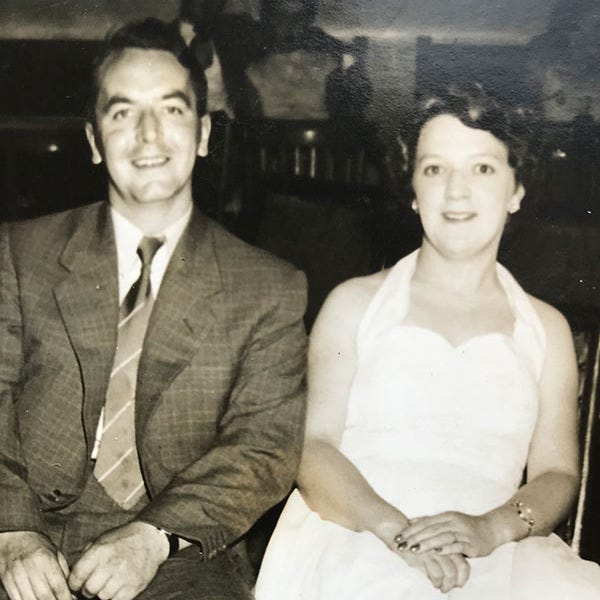A scary memory, from when I was about seven years old, is of my dad standing on the landing, hurling piles of magazines down the stairs and yelling at my mother, below, that nobody needs to keep these. I was in the living room. My little sister was with me. I’m not sure whether my brother was also there. At one point, I ran the gauntlet of the missiles and shouted to him, “Stop! Stop it!” but he carried on.
What happened after, I can’t remember, but the relentless thunk of those magazines hitting the floor. His fury. That’s crystal clear. It stuck, because I’d not seen him throw a physical tantrum before and I was shell-shocked.
Whether they got rid of any magazines that day, I don’t know. Clearing my parents’ house after they died, there were still boxes of them in the cubby hole, dating back to 1953, the year before they met; two years before their wedding. Woman and Beauty, Modern Woman, Good Taste. Then Family Doctor and Homemaker, which mum subscribed to after they married.
I dropped off most copies of Family Doctor at the charity shop, but those women’s magazines were stunning and a window onto a different era. Of course, I brought them home with me.
Magazines have played a big part in my life. I was an avid reader of Bunty as a child, moving on to Romeo, Jackie, 19, She and Cosmopolitan as I grew up. I later worked at Just Seventeen, then contributed to More! and, after I had children, Parents.
I’m fascinated by the way magazines reveal what their readers of the time were meant to aspire to. I mean, wow! If the minx on the cover1 of Modern Woman, April 1953, needed AJ Cronin to mansplain marriage to her, then who wouldn’t want to listen to his advice?! (AJ Cronin was a doctor and novelist. His 1937 novel, The Citadel, about an idealistic Scottish doctor working in Wales and London, apparently paved the way for the NHS in 1948.)
What is AJ Cronin’s marriage advice, you ask? Nuggets include:
The rocky road of life demands stronger apparel than a sheer silk négligée.
The Vicar of Wakefield, in Goldsmith’s novel, came very close to the point. He chose his wife, as she chose her wedding gown, for qualities that would wear well.
A couple will ‘walk out’ together for several years, getting to know each other in steady companionship, discussing the future, saving their money, making practical arrangements for their life together, so that when, after this period of probation, they finally settle down, they do so on a solid foundation of understanding and respect, threatened by none of those dangers that so often blight the beginnings of matrimony.
He goes on: Loyalty is key. Children cannot save a basically unstable marriage. Adultery and disloyalty are home-wreckers. A sense of humour helps. And he gives us a glimpse into his own 25-year marriage:
There have been moments when I would have cheerfully strangled my wife and massacred my children, moments also when they, on their side, would gladly have torn me limb from limb. Yet although at times the going has been difficult, the chief joys of my life have come from my family, the greatest happiness I now look forward to, is centred on it.
Gosh, visceral stuff, AJ. But in a nutshell: family values rule.
Elsewhere in the magazine, the public’s fascination with the royal family in the run-up to Queen Elizabeth II’s coronation in June 1953, is satisfied by Buckingham Palace’s female Press Correspondent, Betty Spencer Shew.

King Charles at age four was, apparently, “Needle-sharp, lively as a cricket.” We learn over the page that he has started to paddle and “make some show of swimming”, that his pets include a canary and a white rabbit named Harvey. His Shetland pony is housed at Windsor. And “He dances up and down whenever he hears a band, whilst the skirl of the pipes sends him into ecstasies.” He has received a miniature set of bagpipes and loves to bang a toy drum and blow a mouth organ.
Body shaming is nothing new. A Gossard ad for foundation garments asks, “Can you face a full-length mirror? Shame on you if you let your figure run away with itself!”
There’s beauty, there’s fashion, cookery, tips on childcare and home-making. But, tellingly, for the Modern Woman of 1953, aside from brief mentions of female journalists and movie stars, there’s no evidence of careers.
A feature about upcoming labour-saving devices says they might “free her from drudgery, and lavish on her the leisure to fulfill her creative purpose in her home”.
“I’ve never before felt myself to be in such a dreadful tangle”
My mum knew she would struggle to live up to the image of the 1950s housewife. She considered breaking off their engagement, writing my dad a long letter (which I also found when clearing the house they lived in their whole 66-year married life) about all the ways in which she thought she might fall short, despite her best efforts.
When she wrote this letter to my dad, she was 24, living with her parents, doing a clerical job and giving part of her salary to her mother every week. Here are some snippets:
I just hadn’t been thinking of engagement or marriage until a short time before, and I felt very strongly that I was just learning to enjoy myself, and that I was not ready yet to settle down. Perhaps it’s different for a boy – I don’t know; but I was just beginning to be able to afford to dress as I liked to dress and to go to the places and do the things which interested me. I was at last independent and able to enjoy my independence.
… time and energy should not be wasted on doing things which are sheer drudgery, if they can possibly be avoided. Many of the things which a housewife has had to put up with for years would not be tolerated for a moment in an efficient factory (or in an inefficient one, for that matter) and it’s the realisation of some of these difficulties that has brought many labour-saving things on to the markets.
If you’ve thought about it since, you’ve probably realised that your statement about a husband working long hours to keep his wife in comfort and luxury is, in 99 cases out of 100, sheer bunkum (if you’ll pardon the expression).
I’m not disputing the long hours and hard work – as I said, I can sympathise there strongly. But comfort and luxury are very rare things for a normal housewife to enjoy! And she’s often forfeited a good job and salary, don’t forget!
Can you imagine just how I’m feeling about all this? You must have an extremely vivid imagination if you can, for I’ve never before felt myself to be in such a dreadful tangle, and all this just when according to the rules, everything is going far better than we could have dreamed possible?
Although I’d never seen the letter before (it was tucked in the back of an ancient wallet of my dad’s), my mum had told me about her doubts about marriage. Just at the moment she thought of returning the engagement ring to dad, they happened to run into my dad’s old headteacher, Ben Robey (yes, the same Ben Robey I mentioned in my piece In Praise of Playing Out and the film, Kes) and he spoke so highly of my dad as a former pupil that she changed her mind and kept the ring on her finger.
Those aspirational magazines were a reminder of the kind of wife mum struggled to be. To my dad, they were rubbish in the cubby hole, a waste of space, a frivolous expense.
I’m glad some of them were saved. And of course, I’m glad they did marry, or my brother, sister and I would not be here. We loved them both dearly. But I wonder who mum might have been if the boundaries for women had been different.
© Wendy Varley 2024
Thanks to everyone who responded to my piece last week, After the Flood. I was nervous about sharing something so personal, but the feedback was truly heartwarming. Plus, thanks to everyone who’s newly subscribed. Welcome!
Clicking the heart, commenting and/or sharing this piece will help other people find my writing. And please do comment below. Did anything surprise you about what women’s magazines in 1953 covered, or said about the times? Did you have to fight against expectations about what you could achieve when you were growing up?
Thanks for reading. Till next time!
If you enjoyed this, do please join my happy band of subscribers at Wendy’s World. Everything is free for all to read. There is also a paid option. If you choose it, you will be helping to support my writing. Thank you!
Or, if you’d like to support my writing with a one-off payment, that’s also very welcome :-)
I was asked after publishing this, whether the model on the cover of Modern Woman got a credit. Yes, she did! She is June Clarke, “wearing a new coronet hat designed for us by Parisienne, Jenny Fisher”, and she models the Coronet hats in the magazine, too. Looking her up, there there are photos of her by Norman Parkinson in the National Portrait Gallery.









Good reminder. I graduated high school in 1952 fighting against the norms stated in the US equivalent of those magazines. I went to college headed for a career in theatre and broadcasting while avoiding marriage. And then I did get married and despite my independence fell into a poor example of the life I'd avoided. I had no idea what I could demand from my husband or how the chores of marriage and family could be shared. There were publications to support my plight, I think, but I was still reading the ones like the ones your mother read. I did manage to sell designs to Women's Day and articles to Parents Magazine, but it took a long time to gain my lost freedom. In the long run I have no regrets having produced two beloved offspring, and by extension a slew of amazing grands, as well as a life now at 90 that is and has been everything I wanted.
Your posts are always so thoughtful and thought-provoking. This is absolutely fascinating and really highlighted how different today's world seems than even a few decades in the past. I feel grateful to have had a 20s steeped in independence and discovery.
Your mother's words are haunting: "I felt very strongly that I was just learning to enjoy myself...I was just beginning to be able to afford to dress as I liked to dress and to go to the places and do the things which interested me. I was at last independent and able to enjoy my independence."
I can't help but feel that her keeping that letter all this time was somewhat intentional -- a reminder of who she was before she became a "wife" and "mother." I think we all need to keep those memories of that version of ourselves close to us! Thank you for sharing.